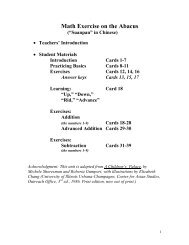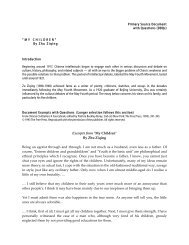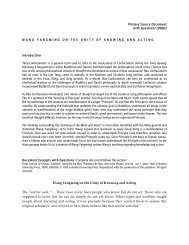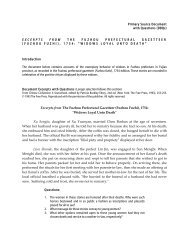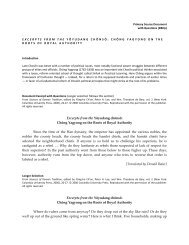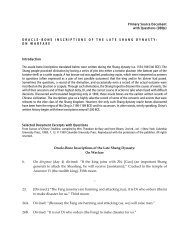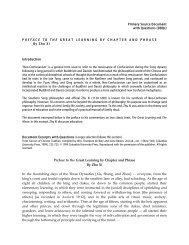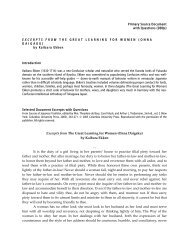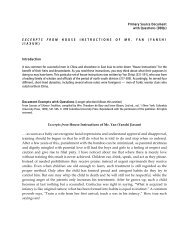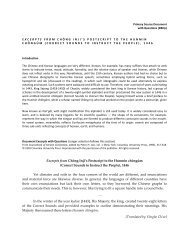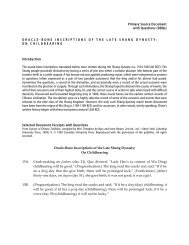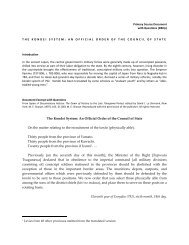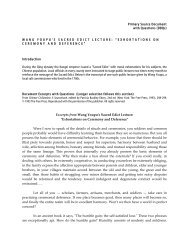Tokugawa Ieyasu on Military Government and the Social Order [PDF]
Tokugawa Ieyasu on Military Government and the Social Order [PDF]
Tokugawa Ieyasu on Military Government and the Social Order [PDF]
- TAGS
- tokugawa
- ieyasu
- www.yumpu.com
You also want an ePaper? Increase the reach of your titles
YUMPU automatically turns print PDFs into web optimized ePapers that Google loves.
Primary Source Documentwith Questi<strong>on</strong>s (DBQs)TOKUGAWA IEYASU ON MILITARY GOVERNMENT AND THESOCIAL ORDERIntroducti<strong>on</strong><str<strong>on</strong>g>Tokugawa</str<strong>on</strong>g> <str<strong>on</strong>g>Ieyasu</str<strong>on</strong>g> (1543-1616) was <strong>the</strong> third of <strong>the</strong> three great unifiers of Japan <strong>and</strong> <strong>the</strong> founder of <strong>the</strong> <str<strong>on</strong>g>Tokugawa</str<strong>on</strong>g>shogunate that ruled Japan from 1603 to 1868. The establishment of a stable nati<strong>on</strong>al regime was a substantialachievement, as Japan had lacked effective <strong>and</strong> durable central governance for well over a century prior to <str<strong>on</strong>g>Ieyasu</str<strong>on</strong>g>’srise.Creating <strong>the</strong> <str<strong>on</strong>g>Tokugawa</str<strong>on</strong>g> system of rule required a variety of sweeping political <strong>and</strong> social reforms, n<strong>on</strong>e perhaps witha more profound impact than <strong>the</strong> divisi<strong>on</strong> of society into four hereditary status groups (often called classes) based <strong>on</strong>occupati<strong>on</strong>, known in Japanese as <strong>the</strong> shinōkōshō (samurai, peasants, artisans, merchants). In this short document,written by an unidentified retainer in <strong>the</strong> early seventeenth century, <str<strong>on</strong>g>Ieyasu</str<strong>on</strong>g>’s c<strong>on</strong>cepti<strong>on</strong> of <strong>the</strong> <str<strong>on</strong>g>Tokugawa</str<strong>on</strong>g> socialhierarchy is recorded.Selected Document Excerpts with Questi<strong>on</strong>s (L<strong>on</strong>ger selecti<strong>on</strong> follows this secti<strong>on</strong>)From Sources of Japanese Traditi<strong>on</strong>, edited by Ryusaku Tsunoda <strong>and</strong> Wm. Theodore de Bary, 1st ed., vol. 1 (New York: ColumbiaUniversity Press, 1964), 329-330. © 1964 Columbia University Press. Reproduced with <strong>the</strong> permissi<strong>on</strong> of <strong>the</strong> publisher. All rightsreserved.<str<strong>on</strong>g>Tokugawa</str<strong>on</strong>g><str<strong>on</strong>g>Ieyasu</str<strong>on</strong>g><strong>on</strong><strong>Military</strong><strong>Government</strong><strong>and</strong><strong>the</strong><strong>Social</strong><strong>Order</strong>Once, Lord Tōshō [<str<strong>on</strong>g>Ieyasu</str<strong>on</strong>g>] c<strong>on</strong>versed with H<strong>on</strong>da, Governor Sado, <strong>on</strong> <strong>the</strong> subject of <strong>the</strong>emperor,<strong>the</strong>shogun,<strong>and</strong><strong>the</strong>farmer.“…<strong>the</strong>truemasterof<strong>the</strong>wayof<strong>the</strong>warrioris<strong>on</strong>ewhomaintainshismartialdisciplineevenintimeofpeace.…<strong>the</strong>farmer’stoilisproverbial...Heselects<strong>the</strong>seedfromlastfall’scrop,<strong>and</strong>undergoesvarioushardships<strong>and</strong>anxietiesthrough<strong>the</strong>heat of <strong>the</strong> summer until <strong>the</strong> seed grows finally to a rice plant. ...The rice <strong>the</strong>n becomes <strong>the</strong>sustenance for <strong>the</strong> multitudes. ...<strong>the</strong> artisan’s occupati<strong>on</strong> is to make <strong>and</strong> prepare wares <strong>and</strong>utensilsfor<strong>the</strong>useofo<strong>the</strong>rs....<strong>the</strong>merchantfacilitates<strong>the</strong>exchangeofgoodssothat<strong>the</strong>peoplecancover<strong>the</strong>irnakedness<strong>and</strong>keep<strong>the</strong>irbodieswarm.…[FromKorōshodan,inDai‐Nih<strong>on</strong>shiryō,Part12,Vol.24,pp.546‐549]Questi<strong>on</strong>s:1. Why do you think occupati<strong>on</strong>s were ranked in this order in <str<strong>on</strong>g>Tokugawa</str<strong>on</strong>g> Japan?2. Why was <strong>the</strong> farmer’s importance to society placed above that of <strong>the</strong> artisan<strong>and</strong> <strong>the</strong> merchant?3. Are occupati<strong>on</strong>s ranked this way today?


![Tokugawa Ieyasu on Military Government and the Social Order [PDF]](https://img.yumpu.com/40495803/1/500x640/tokugawa-ieyasu-on-military-government-and-the-social-order-pdf.jpg)
